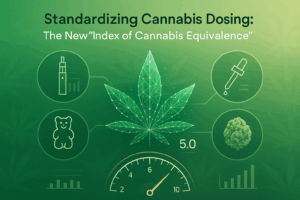From Jungle to GMP: Colombia’s Road to Pharmaceutical Cannabis
🟢 Why Read? Colombia’s transformation from grower to pharma-grade supplier is a story worth sharing.
From Jungle to GMP: Colombia’s Road to Pharmaceutical Cannabis
Colombia has come a long way—from wild jungle stereotypes to one of the most trusted sources of pharmaceutical-grade cannabis. Thanks to ideal growing conditions, smart regulations, and a serious push for EU-GMP compliance, Colombia is now on the radar of global buyers who demand both quality and consistency. This isn’t just about sunshine and low costs—it’s about producing clean, tested, export-ready flower that can stand next to the best in the world. Let’s take a look at how Colombia made the leap—from green fields to white lab coats.
🔹 A Brief Look at Colombia’s Cannabis Evolution
(From traditional crops to pharma-grade exports — here’s how Colombia became a cannabis contender)
If someone mentioned Colombian cannabis a decade ago, chances are they weren’t talking about legal, pharmaceutical-grade flower with EU-GMP ambitions. But fast-forward to today, and Colombia is gaining international respect as a serious player in the global medical cannabis market—and doing it with sun-grown charm and science-backed structure.
So how did this transformation happen? It didn’t happen overnight, and it definitely didn’t happen by accident. Let’s take a quick trip through Colombia’s cannabis journey—from humble roots to certified labs.
1. The Roots: Where It All Started
Colombia has always had a strong relationship with the cannabis plant. In fact, cannabis grew wild and widely in many parts of the country, long before anyone thought about permits or exports.
For decades, informal cultivation thrived—mainly for local use or underground trade. But while the international image focused on illegal operations, Colombians knew the plant’s agricultural potential, especially in the country’s lush, fertile regions.
The turning point came in the early 2010s, when policymakers began realizing that legal cannabis could mean jobs, economic development, and global opportunity—especially for post-conflict rural areas looking for sustainable crops.
💡 Fun fact: Colombia’s geography is perfect for cannabis. Sunlight year-round, diverse microclimates, and experienced farmers made it an ideal match for medicinal cultivation.
2. Legalization & Regulation: The Real Game Changer
In 2016, Colombia passed legislation that created a regulated framework for the cultivation, production, and export of medicinal cannabis. This was a massive shift, and it opened the doors for local companies—and international investors—to build something new.
The government didn’t just say “go grow.” They implemented a structured licensing system, managed by INVIMA and the Ministry of Justice, to ensure that cannabis production would meet strict pharmaceutical and international trade standards.
Licenses were issued for:
🌱 Cultivation of psychoactive and non-psychoactive cannabis
🏭 Transformation and processing of extracts
📦 Export of raw materials and finished products
This level of regulation attracted serious players—scientists, agronomists, entrepreneurs—who began building state-of-the-art facilities with real traceability, testing, and compliance systems.
✅ The result? Colombia started shifting from an “emerging market” to a country that could actually compete with Canada, Portugal, and beyond.
3. The GMP Era: Colombia Gets Certified
The next big milestone was the push for EU-GMP certification—the gold standard for medical cannabis exports to Europe. While some countries struggled to meet the complex requirements, Colombian producers embraced the challenge.
Why? Because they knew global buyers wanted more than sunshine—they wanted:
📊 Batch-level traceability
🧪 Lab-tested consistency
📦 Proper packaging, handling, and documentation
📁 Regulatory alignment with importing countries
Many Colombian companies began upgrading their operations to comply with GACP (Good Agricultural and Collection Practices) and GMP (Good Manufacturing Practices). Some even built on-site labs, data tracking systems, and EU-compliant facilities from the ground up.
And the effort paid off. Today, Colombia has multiple companies with GMP certification and several more on the way—meaning buyers from Germany, the UK, and Australia can now import flower and extracts with confidence.
Final Thoughts: From Fields to Pharma (And Still Growing)
Colombia’s evolution in the cannabis industry is nothing short of impressive. In just a few years, it has gone from informal crops to one of the world’s most promising sources of medicinal cannabis.
What makes this story even better is that the country didn’t just follow trends—it invested in regulation, education, and infrastructure to make sure its cannabis exports meet the highest standards.
So if you’re a buyer looking for reliable, tested, and scalable cannabis, Colombia isn’t just an option—it’s becoming a top-tier destination.
🌿 Want to see how Colombian flower compares? Let’s just say: sunny, certified, and ready to ship.
💬 Worked with Colombian suppliers? Share your experience or questions below—let’s grow this conversation!
🔹 How Local Growers Are Meeting Global Standards
(And why Colombian cannabis is turning heads in boardrooms, not just greenhouses)

Let’s get one thing straight—growing great cannabis is one thing, but growing cannabis that meets international pharmaceutical standards? That’s a whole different game. Thankfully, many Colombian producers are playing that game—and playing it well.
Colombia is not just shipping flower anymore. It’s shipping confidence. Buyers from Europe, the UK, and Australia are taking notice, not just because the product is great, but because the producers behind it are meeting global standards with surprising speed and professionalism.
So, how are they doing it? Let’s take a look at how local growers are turning sunshine and soil into standardized, GMP-ready exports.
1. Training the Teams: From Farmers to Pharma Pros
A few years ago, most Colombian cannabis farmers were experts in the field—literally. They knew how to grow high-quality flower, manage soil, and work with nature. But global standards require more than green thumbs—they demand documentation, precision, and consistency.
So, many companies began investing in training programs to upskill their teams. Cultivation workers, post-harvest teams, and lab technicians are learning how to:
✅ Follow Standard Operating Procedures (SOPs)
✅ Maintain GACP-compliant environments
✅ Keep detailed batch records and traceability logs
✅ Understand why even trimming scissors need to be sanitized
This mix of traditional knowledge and new-school compliance is turning out some of the best-trained cannabis teams in the region.
💡 It’s not unusual to find a greenhouse in Colombia where the same person pruning the plants can also explain why a certain terpene matters to a German importer.
2. Building Facilities That Impress Auditors
You can’t meet global standards with a shack and a fan. Colombian growers have started building serious infrastructure—greenhouses with climate controls, extraction labs with cleanroom protocols, and drying rooms that feel more like pharmaceutical storage than anything else.
What’s impressive is that many of these operations are built from the ground up with GMP in mind. That means fewer retrofits and more purpose-built facilities designed for:
🏭 Controlled environments
📦 Sealed storage systems
📊 Digital tracking of every input and output
🧪 Integrated labs for in-house testing
Inspectors from importing countries aren’t easy to impress—but several Colombian producers have already passed their audits and are now GMP-certified (or well on the way).
And yes, many of these facilities are surrounded by lush Colombian hills and sunshine, proving you don’t need snow to grow pharma-grade weed.
3. Making Compliance a Daily Habit, Not a Special Event
One of the biggest challenges in meeting global standards is consistency. It’s easy to clean up for an audit. It’s harder to live the standards every day. But that’s exactly what the best Colombian producers are doing.
They’ve built systems that make compliance part of the culture:
📅 Daily logs and digital check-ins
📋 QA teams that monitor every phase of production
🔍 Frequent internal audits—so external ones are no big deal
🧼 Strict hygiene and cleanliness protocols (even for the break room!)
You’ll even hear growers talking about microbial counts and moisture content like it’s the weather—because they’ve made quality part of their everyday language.
This shift in mindset—from “good enough” to “global-grade”—is what really sets Colombia apart right now. It’s not just about regulations. It’s about earning trust with every gram shipped.
Final Thoughts: Colombia’s Growing Reputation Is No Accident
Meeting global cannabis standards isn’t a trend—it’s a full-time job. And Colombian growers are showing the world they’re up to the task.
From hands-on training to cutting-edge infrastructure, and from daily SOPs to real certifications, Colombia is building a new identity in the cannabis space—one that blends agricultural excellence with pharmaceutical precision.
So next time you hear “Colombian cannabis,” don’t just think about sunny fields. Think about GMP facilities, traceable batches, and quality that travels well across borders.
🌿 Working with a Colombian supplier? Ask to see their compliance playbook—you might be pleasantly surprised.
💬 Drop a comment if you’ve toured a Colombian facility or want help choosing one that fits your needs!
🔹 What EU-GMP Means (Without the Boring Stuff)
(Because no one wants to read a 300-page manual to understand if your flower is pharmacy-ready)
If you’ve spent any time in the world of cannabis exports—especially to Europe—you’ve probably heard the term EU-GMP tossed around like confetti at a cannabis conference. Sounds fancy, right? It is. But it’s also essential if you want your flower or oil to land in pharmacies, clinics, or white-label products across Europe.
The problem? Most explanations of EU-GMP sound like someone copied them from a pharmaceutical law textbook. We’re not doing that here. This guide is all about breaking it down in plain English, so you actually understand what buyers want, why it matters, and how countries like Colombia are rising to the occasion.
Let’s simplify the jargon and talk about what EU-GMP really means—without the glazed-over eyes and legal headaches.
1. EU-GMP = Trust, Traceability, and Zero Guesswork
Let’s start with the basics: EU-GMP stands for European Union Good Manufacturing Practice. It’s a strict set of rules that tells cannabis producers how to grow, process, test, and handle their products to meet pharmaceutical-level safety and consistency.
Think of it like this:
🧪 GACP (Good Agricultural Practices) = How you grow it
🏭 GMP (Good Manufacturing Practices) = How you process and package it
🇪🇺 EU-GMP = Europe’s official stamp that says: “This product meets our high standards”
Buyers don’t want surprises. They want to know that if they order 20kg of flower today and another 20kg next month, both will perform the same, meet all health standards, and pass any lab test thrown at them.
EU-GMP ensures your cannabis doesn’t just look good—it behaves like a reliable, standardized, pharmaceutical product.
2. It’s Not Just Clean Rooms—It’s a Culture of Compliance
Some people think EU-GMP means shiny facilities and lab coats, and while that’s part of it, it’s much deeper than appearance. It’s about how everything is done, every single day—from seed to shipment.
To be EU-GMP certified, your facility needs:
✅ Written procedures for everything (yes, even how you wash your hands)
✅ Full traceability—so every gram of flower can be tracked back to the mother plant
✅ Controlled environments to avoid contamination
✅ Batch testing and record-keeping that make auditors smile
But the real secret? It’s the culture. Staff need to follow these rules not just for show, but because it’s how they operate every day.
That’s why companies in Colombia that are serious about EU-GMP are investing in training, quality assurance, and full-time compliance teams—not just building fancy rooms.
💡 A Colombian grower once said: “EU-GMP isn’t a certification. It’s a lifestyle.” And honestly? They nailed it.
3. Why Colombian Producers Are Going All-In on EU-GMP
You might be wondering—why are growers in Colombia, a tropical country with natural sunlight and open-air fields, investing so heavily in EU-GMP?
Simple. Because they want to play in the big leagues. And to get their product into Germany, the UK, or Australia, EU-GMP is the golden ticket.
Here’s why Colombia is uniquely positioned to succeed:
🌞 Ideal growing conditions reduce the need for expensive indoor setups
💰 Lower production costs mean they can afford to invest in GMP infrastructure without charging sky-high prices
🧠 Skilled local teams are trained in both agriculture and compliance
📈 Global demand for pharmaceutical cannabis is growing—and Colombia wants a front-row seat
More and more Colombian companies are achieving EU-GMP status—or working toward it—and buyers are taking notice. The result? Affordable, high-quality, compliant cannabis that can cross borders with confidence.
Final Thoughts: GMP Isn’t Just Paperwork—It’s Power
EU-GMP might sound intimidating, but at its core, it’s about building trust between suppliers, regulators, and buyers. If your cannabis is EU-GMP certified, it tells the world:
✅ You take quality seriously
✅ You can scale without cutting corners
✅ You’re ready for the strictest, most profitable markets
And if you’re buying cannabis? It means you can breathe easy, knowing the flower has been grown, processed, and tested to the highest standards available.
So whether you’re a grower looking to upgrade or a buyer looking for compliant supply—Colombia is proving it’s more than ready for the EU-GMP spotlight.
🌿 Want to work with an EU-GMP-ready producer? Or just curious about what it takes to get certified? Let’s talk. Drop your questions below!
🔹 Why European Buyers Are Taking Colombia Seriously
(It’s not just the sunshine—Colombia is quietly becoming Europe’s favorite source of medical-grade cannabis.)

When people think of Colombia, they usually picture coffee, Caribbean beaches, or salsa dancing—but now, they might want to add EU-GMP-certified cannabis to that list. Because behind the scenic mountain views and year-round sunshine, Colombia has been building something serious: a reliable, affordable, and compliant supply chain for the global cannabis market.
And guess what? European buyers have noticed. From Germany to the UK, more distributors, clinics, and pharmaceutical importers are looking south—not for fun, but for flower. Let’s unpack why Colombia is quickly becoming a favorite for Europe’s strict medical markets.
1. They’re Delivering the Right Product—Not Just the Right Price
Sure, Colombia has long been praised for its low-cost production—thanks to abundant sunlight, ideal humidity, and a skilled agricultural workforce. But European buyers aren’t just hunting for bargains. They want medical-grade flower that passes inspections and performs consistently.
And that’s exactly what Colombian producers are delivering. They’ve shifted from simply growing “good weed” to growing clean, tested, and traceable cannabis that meets European quality demands.
Here’s what makes the product so attractive:
✅ High-quality flower with diverse cannabinoid and terpene profiles
✅ Batch-to-batch consistency, with proper documentation
✅ Third-party lab testing done to global standards
✅ Dry, trimmed, and packaged properly—no more surprises at customs
💡 The result? European buyers get product they can actually sell and prescribe—without headaches or extra compliance drama.
2. Colombian Suppliers Are Speaking Europe’s Language (Literally and Figuratively)
Doing business across continents can be tricky. Time zones, language barriers, unclear paperwork—these little things add up fast. But Colombian exporters have learned that professionalism and communication matter just as much as the product itself.
Today, many Colombian companies have:
📬 Multilingual export teams who speak English, German, and even Portuguese
📦 Customs-ready documentation, including lab results, batch numbers, and shipping records
📅 Reliable logistics partners that understand import regulations
💬 Responsive customer service that doesn’t leave you hanging
And because many of them are working toward or already hold EU-GMP or GACP certifications, they’re aligning their operations with what European regulators expect—not just what they can get away with.
🧠 Translation: You get clear communication, clean documentation, and a smoother import process from seed to shelf.
3. Flexibility and Scale—Without Sacrificing Quality
One thing European buyers love about Colombia? The ability to scale quickly without losing control over product quality.
Need 10kg of a THC-rich flower now and 100kg of a balanced strain next month? Colombian producers are increasingly equipped to handle these types of requests—without compromising on testing, packaging, or paperwork.
Why this works:
🌿 Year-round growing seasons = constant supply
🔁 Shorter harvest cycles = faster turnaround
🏗️ Smart infrastructure = ability to handle small and large orders
🧪 Standardized procedures = quality you can trust
Plus, since labor and energy costs are lower in Colombia, you’re not just scaling—you’re doing it without the crazy price tag that comes from some indoor-only markets.
Final Thoughts: Colombia Isn’t a Secret Anymore
European buyers used to look only at Canada, the Netherlands, or Portugal for cannabis. Now? Colombia is right up there with the best of them—and sometimes ahead.
The mix of ideal natural conditions, serious compliance efforts, and export-ready professionalism makes it a smart choice for any buyer who wants reliable product at a fair price.
So if you’re sourcing for a European distributor, medical program, or pharmacy chain, Colombia isn’t just “an option.” It’s becoming the obvious next move.
🌍 Already working with Colombian suppliers? Or thinking about making the switch? Share your thoughts—we’re all ears (and COAs).




